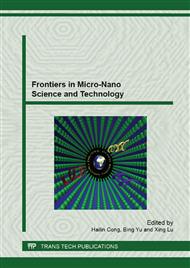[1]
S. Nakamura, T. Mukai, M. Sench, Candela-class high-brightness InGaN/AlGaN double-heterostructure blue-light-emitting diodes, Appl. Phys. Lett. 64 (1994) 1687–1689.
DOI: 10.1063/1.111832
Google Scholar
[2]
P.F. Smet, K. Korthout, J.E. Van Haecke, D. Poelman, Using rare earth doped thiosilicates phosphors in white-light emitting LEDs: towards low colour temperature and high colour rendering, Mater. Sci. Eng. B 146 (2008) 264–268.
DOI: 10.1016/j.mseb.2007.07.042
Google Scholar
[3]
S. Neeraj, N. Kijima, A.K. Cheetham, Novel red phosphors for solid-state lighting: the system NaM(MoO4)x(WO4)1−x: Eu3+ (M = Gd, Y, Bi), Chem. Phys. Lett. 387 (2004) 2–6.
DOI: 10.1016/j.cplett.2003.12.130
Google Scholar
[4]
F. Lei, B. Yan, Hydrothermal synthesis and luminescence of CaMO4: RE3+ (M = W, Mo; RE = Eu, Tb) submicro-phosphors, J. Solid State Chem. 181 (2008) 855–862.
DOI: 10.1016/j.jssc.2008.01.033
Google Scholar
[5]
C.F. Guo, D.X. Huang, Q. Su, Methods to improve the fluorescence intensity of CaS: Eu2+ red-emitting phosphor for white LED, Mater. Sci. Eng. B 130 (2006) 189–193.
DOI: 10.1016/j.mseb.2006.03.008
Google Scholar
[6]
C. Kodaira, H.F. Brito, M.C.F.C. Felinto, Luminescence investigation of Eu3+ ion in the RE2(WO4)3 matrix (RE = La and Gd) produced using the Pechini method, J. Solid State Chem. 171 (2003) 401–407.
DOI: 10.1016/s0022-4596(02)00221-9
Google Scholar
[7]
Y.C. Kang, H.S. Roh, S.B. Park, Preparation of Y2O3: Eu phosphor particles of filled morphology at high precursor concentrations by spray pyrolysis, Adv. Mater. 12 (2000) 451-453.
DOI: 10.1002/(sici)1521-4095(200003)12:6<451::aid-adma451>3.0.co;2-s
Google Scholar
[8]
W.Q. Yang, H.G. Liu, G.K. Liu, Y. Lin, M. Gao, X.Y. Zhao, W.C. Zheng, Y. Chen, J. Xu, L.Z. Li, Trivalent europium-doped strontium molybdate red phosphors in white light-emitting diodes: Synthesis, photophysical properties and theoretical calculations, Acta Mater. 60 (2012).
DOI: 10.1016/j.actamat.2012.06.052
Google Scholar
[9]
Z. Ci, Y. Wang, J. Zhang, Y. Sun, Ca1-xMo1-ySiyO4: Eux3+: A novel red phosphor for white light emitting diodes, Physica B. 403 (2008) 670-674.
DOI: 10.1016/j.physb.2007.09.071
Google Scholar
[10]
X. Li, Z.P. Yang, L. Guan, Q.L. Guo, S.F. Huai, P.L. Li, Synthesis and properties of Eu3+ activated strontium molybdate phosphor, J. Rare Earth. 25 (2007) 706-709.
DOI: 10.1016/s1002-0721(08)60011-3
Google Scholar


